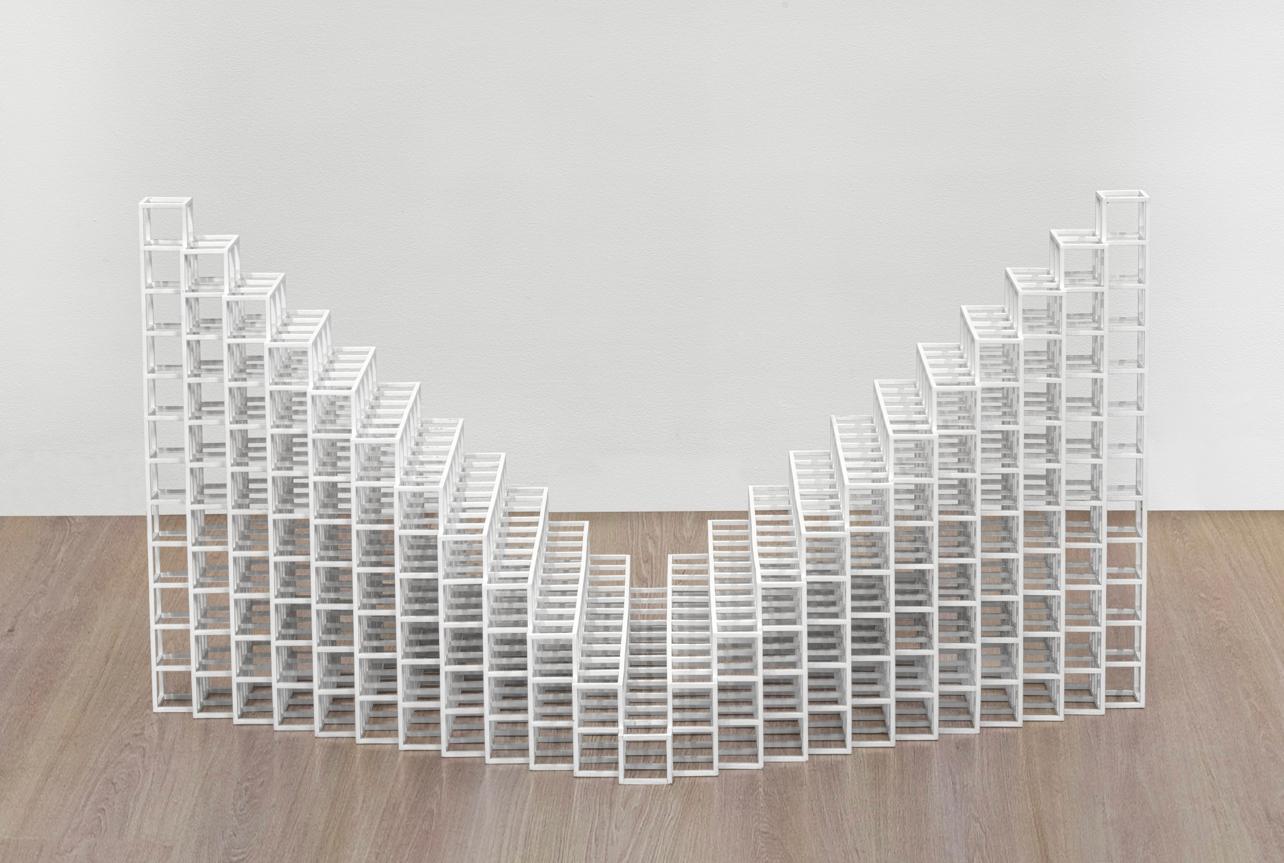Sol LeWitt Low in the Center
1996
Painted wood
Signed and dated
28.74 x 29.92 in ( 73 x 76 cm )ZoomInquiry - Low in the Center, 1996
Provenance
Barbara Krakow, Boston
Private Colelction, Belgium
Artwork's description
In Low in the Center, created in 1996, Sol LeWitt, a key figure in conceptual art and a pioneer of minimalism, reveals his fascination with the simple geometry of the cube, which he described as the "grammatical device". According to LeWitt, the cube is a neutral form, devoid of aggression, emotion, or movement, making it the ideal foundation for more complex compositions. In this piece, the artist explores the beauty of the line, repetition, and serialization, highlighting his commitment to formal rigor.
Born in 1928 in Hartford, Connecticut, LeWitt distinguished himself with an innovative approach that prioritized the idea over the finished object. His work in the office of architect I.M. Pei in 1955 significantly influenced his artistic vision, shaping his relationship with space and structure. LeWitt refused to refer to his works as sculptures, preferring the term «structures,» a choice that reflects the architectural dimension of his creations.
In Low in the Center, LeWitt combines mathematical rigor with the freedom of intuitive execution. This marriage between rationality and spontaneity imbues the work with a contemplative quality, where balance and seriality invite the viewer to a meditative reflection. Through this piece, LeWitt demonstrates his ability to create timeless forms while transcending the boundaries of traditional sculpture.
Artist's biography
Sol LeWitt, born September 9, 1928, in Hartford, Connecticut, and deceased April 8, 2007, in New York City, was a pivotal figure in the development of conceptual art and minimalism. His work, characterized by its systematic and geometric nature, explored the boundaries of artistic expression and the role of the artist in the creative process. LeWitt's contributions to the art world have left an enduring legacy, influencing countless artists and reshaping contemporary art practices.
Solomon "Sol" LeWitt was born to a Jewish family of Eastern European descent. His father, a doctor, died when LeWitt was six, prompting his mother to move the family to New Britain, Connecticut. As a child, LeWitt showed an early interest in art, encouraged by his mother and an art teacher at New Britain High School.
After graduating in 1945, LeWitt attended Syracuse University, where he earned a Bachelor of Fine Arts degree in 1949. Following his graduation, he traveled to Europe, immersing himself in the works of old masters and contemporary artists alike, experiences that would later inform his own artistic practices.
In 1953, LeWitt moved to New York City, where he attended classes at the School of Visual Arts and took various odd jobs, including working as a graphic designer for architect I.M. Pei and as a night receptionist at the Museum of Modern Art. It was during his time at the museum that he met fellow artists Robert Ryman, Dan Flavin, and Robert Mangold, who would become key figures in the minimalism and conceptual art movements.
LeWitt's early works were influenced by his background in graphic design and his interest in architectural structures. However, it was in the 1960s that he began to formulate his ideas about conceptual art. In 1967, LeWitt published his seminal essay "Paragraphs on Conceptual Art" in Artforum, where he argued that "the idea becomes a machine that makes the art." This notion underscored the primacy of the concept over the execution, challenging traditional notions of artistic authorship and craftsmanship.
One of LeWitt's most significant contributions to art was his series of "Wall Drawings," begun in 1968. These works, created directly on the walls of galleries and museums, followed detailed instructions provided by LeWitt. The first, "Wall Drawing #1," consisted of pencil lines drawn directly on the wall. This approach emphasized the idea over the physical artwork and allowed for the possibility of the work being recreated by others.
LeWitt's wall drawings became increasingly complex over time, incorporating color and intricate geometric patterns. "Wall Drawing #51" (1970), for example, consists of a series of not straight lines in four directions, creating a dense and dynamic visual field. Another notable work, "Wall Drawing #146A" (1972), involves parallel lines in different colors, showcasing his exploration of color and form.
In addition to wall drawings, LeWitt is known for his "Structures," a term he preferred over "sculptures." These three-dimensional works, often made from materials such as wood or metal, explore modular forms and repetitive systems. A prominent example is "Four-Sided Pyramid" (1997), a large-scale installation composed of open, cubic units stacked to form a pyramid, reflecting his interest in architectural form and systematic construction.
LeWitt also produced a series of "Serial Projects," which investigate variations within a set system. "Serial Project #1 (ABCD)" (1966) exemplifies this approach, presenting a grid of open cubes arranged according to a predetermined logical sequence. These works emphasize the process of creation and the underlying structures governing visual form.
Throughout his career, LeWitt continued to experiment with different media and methods. In the 1980s and 1990s, he expanded his practice to include works on paper, prints, and large-scale installations. His later wall drawings often featured bold colors and more complex patterns, as seen in "Wall Drawing #1107" (2003), which combines curving forms and vibrant hues.
LeWitt's influence extends far beyond his own works. His ideas about the primacy of concept and the role of the artist as a facilitator rather than a creator have shaped contemporary art practices and theories. His work is held in major collections worldwide, including the Museum of Modern Art in New York, the Tate Modern in London, and the Centre Pompidou in Paris.
